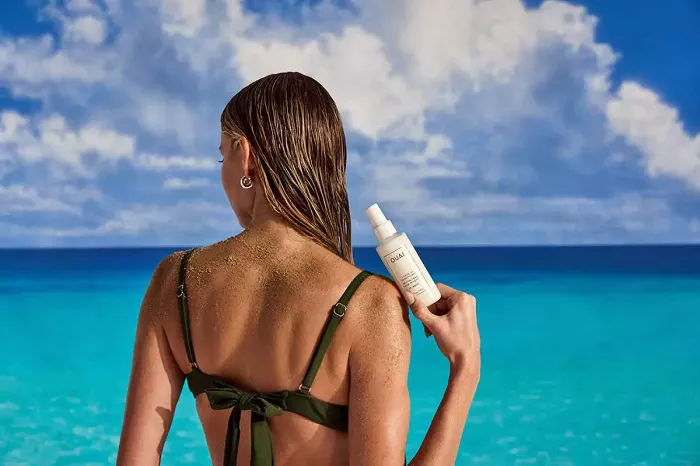As summer heats up, many blondes face a harsh reality: chlorine doesn’t discriminate. Regardless of how much time or money you’ve invested in your blonde hair—be it a pricey balayage or hours under the foils—chlorine in pools can quickly undo your efforts. This chemical culprit oxidizes hair strands, strips natural oils, and transforms vibrant blonde locks into dull, brittle hair.
The most common mistake blondes make during pool season? Swimming without any protection. While refreshing, pool water is chemically aggressive. “Chlorine can severely damage your hair and literally annihilate your color,” warns Adam Livermore, global artist with Oribe Hair Care. Even saltwater pools aren’t safe, as they often contain chlorine or bromine.
Why Chlorine Is a Threat to Hair Health
Chlorine serves as a disinfectant, designed to kill bacteria—but in doing so, it disrupts the hair’s cuticle layer and strips away color molecules. This damage allows oxidation to weaken the hair further, leading to dryness, brittleness, and frizz. Dermatologists also note chlorine breaks down the protein structure of hair, worsening its condition.
Adding insult to injury, minerals in pool water, particularly copper, can react with chlorine to leave an unwanted green tint on blonde hair. For those with thinning hair or scalp sensitivity, chlorine exposure may accelerate hair loss by stressing follicles.
Effective Hair Health Advice to Protect Blonde Hair from Chlorine
Prevention remains the best approach. A swim cap is the most foolproof barrier, but for those who find caps unappealing, Livermore suggests a practical alternative: “Comb coconut oil through dry hair and twist it into a treatment bun before swimming.” This natural oil helps block water penetration.
Another simple tip is to wet your hair with clean tap water before entering the pool. “Think of your hair like a sponge—wet hair absorbs less chlorine than dry hair,” Livermore explains. This pre-swim routine prevents your strands from being “hungry” for chlorinated water.
Pre-Swim Hair Health Tips:
Saturate hair with clean tap water.
Apply generous coconut oil or a leave-in conditioner to form a protective barrier.
Secure hair into a bun or braid and cover with a silicone swim cap.
The Science Behind Coconut Oil and Hair Protection
Coconut oil’s molecular structure enables it to penetrate the hair shaft, sealing in moisture and reducing chlorine absorption. However, it only works when applied beforehand and in sufficient amounts. Keep in mind, coconut oil doesn’t offer UV protection, so pairing it with a UV-protective spray is crucial for sun exposure after swimming.
Repairing Chlorine-Damaged Hair
If you’ve already suffered from dry, brittle, or green-tinged hair, immediate care is necessary. Experts recommend:
Chelating shampoos to remove chlorine and mineral buildup.
Protein-rich masks to rebuild hair strength.
Color-safe shampoos and conditioners to restore moisture.
Purple toners to counteract brassiness and green hues.
Avoid sulfate-based clarifying shampoos, as they can strip remaining color and worsen dryness.
Hydration’s Role in Maintaining Hair Health
Proper hydration is often overlooked in hair care. Hair, primarily made of keratin, requires water to stay elastic and resilient. Dehydration can make hair prone to breakage and chemical damage. This summer, increase your water intake beyond the typical eight cups, especially if you exercise or follow low-carb diets that increase fluid loss.
Leave-In Conditioners: Summer Essentials
Lightweight, UV-protective, and moisture-locking leave-in conditioners are vital. Recommended products include:
Oribe Supershine Moisturizing Cream
OUAI Leave-In Conditioner
Milk_Shake Leave-In Conditioner
Apply from mid-lengths to ends on damp hair before sun exposure and reapply after swimming.
When Damage Is Done: How to Reverse Chlorine Effects
If you skipped protective steps, start recovery immediately:
Rinse hair with filtered water right after swimming.
Use a chelating shampoo to remove chlorine.
Deep condition weekly with masks containing panthenol, keratin, or aloe.
Consider professional gloss or toner treatments to restore color.
Avoid heat styling; air-dry and detangle gently.
You don’t have to choose between enjoying the pool and preserving your blonde locks. With thoughtful hair health advice—whether it’s donning a swim cap, using coconut oil as a protective barrier, or following a post-swim repair routine—you can keep your hair healthy, vibrant, and ready for summer’s fun.
Related Topics:
- Millennial Men Are Fueling the Unexpected Comeback of the Toupee
- Apple Cider Vinegar Emerges as an Affordable, Natural Hair-Care Remedy
- Hair Growth Oils: Do They Really Work and How Long Until You See Results?


